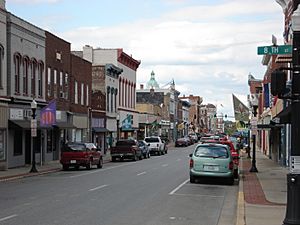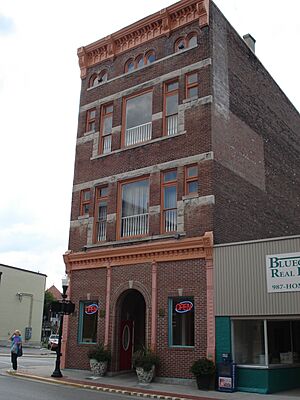Paris, Kentucky facts for kids
Quick facts for kids
Paris, Kentucky
|
|
|---|---|

Downtown Paris
|
|
| Motto(s):
"Thoroughbred Capital of the World"
|
|

Location of Paris in Bourbon County, Kentucky.
|
|
| Country | United States |
| State | Kentucky |
| County | Bourbon |
| Established | 1789 |
| Incorporated | 1839 |
| Reincorporated | 1890 |
| Named for | Paris, France |
| Area | |
| • Total | 8.00 sq mi (20.72 km2) |
| • Land | 7.95 sq mi (20.58 km2) |
| • Water | 0.05 sq mi (0.13 km2) |
| Elevation | 843 ft (257 m) |
| Population
(2020)
|
|
| • Total | 10,171 |
| • Estimate
(2022)
|
10,075 |
| • Density | 1,279.85/sq mi (494.18/km2) |
| Time zone | UTC-5 (Eastern (EST)) |
| • Summer (DST) | UTC-4 (EDT) |
| ZIP codes |
40361-40362
|
| Area code(s) | 859 |
| FIPS code | 21-59196 |
| GNIS feature ID | 2404473 |
Paris is a city in Bourbon County, Kentucky. It's the main city, also called the county seat. It's about 18 miles northeast of Lexington, right by the Stoner Fork of the Licking River. Paris is part of the larger Lexington–Fayette Metropolitan Statistical Area. In 2020, about 10,171 people lived there.
Contents
A Look Back: Paris History
Joseph Houston first settled in this area in 1776. But he had to move because of earlier land claims. Later, in 1786, Lawrence Protzman bought the land where Paris is now.
How Paris Got Its Name
Protzman planned out 250 acres for a town. He offered land for public buildings. In return, he asked the Virginia legislature to make this new settlement the main town for Bourbon County. In 1789, the town officially started. It was first named Hopewell, after Protzman's hometown in New Jersey.
The very next year, the town's name changed to Paris. This was to honor the French capital and thank France for their help during the American Revolution.
Early Settlers
In the late 1700s and early 1800s, many French people came to Paris. They were refugees who had fled the French Revolution. One French settler even came from Calcutta, India, and became a schoolteacher here.
For a short time in the early 1800s, the post office was called Bourbontown or Bourbonton. But the town itself was never officially called that. Paris was officially made a city in 1839 and again in 1890.
Paris is also a "sister city" to Lamotte-Beuvron in France.
Where Paris Is Located
According to the United States Census Bureau, Paris covers about 15.5 square kilometers (about 6 square miles). Most of this area is land, with a small part being water.
Who Lives in Paris?
| Historical population | |||
|---|---|---|---|
| Census | Pop. | %± | |
| 1800 | 377 | — | |
| 1810 | 838 | 122.3% | |
| 1830 | 1,219 | — | |
| 1840 | 1,197 | −1.8% | |
| 1850 | 1,384 | 15.6% | |
| 1860 | 1,440 | 4.0% | |
| 1870 | 2,655 | 84.4% | |
| 1880 | 3,204 | 20.7% | |
| 1890 | 4,218 | 31.6% | |
| 1900 | 4,603 | 9.1% | |
| 1910 | 5,859 | 27.3% | |
| 1920 | 6,310 | 7.7% | |
| 1930 | 6,204 | −1.7% | |
| 1940 | 6,697 | 7.9% | |
| 1950 | 6,912 | 3.2% | |
| 1960 | 7,791 | 12.7% | |
| 1970 | 7,823 | 0.4% | |
| 1980 | 7,935 | 1.4% | |
| 1990 | 8,730 | 10.0% | |
| 2000 | 9,183 | 5.2% | |
| 2010 | 8,553 | −6.9% | |
| 2020 | 10,171 | 18.9% | |
| 2022 (est.) | 10,075 | 17.8% | |
| U.S. Decennial Census | |||
The city's population has grown a lot over the years. In 1800, there were only 377 people. By 2020, the population had reached 10,171.
In 2000, most people in Paris were White (84.23%). About 12.71% were African American. A small number of people were from other racial backgrounds. About 2.62% of the population was Hispanic or Latino.
Many households in Paris had children under 18 living with them. The average household had about 2.33 people. The median age in the city was 36 years old.
Arts and Culture in Paris
Between 2006 and 2008, fifteen buildings in downtown Paris were updated.
Here are some cool places and events in Paris:
- Downtown Paris ARTWALK: This is a special event where you can see lots of art.
- Nannine Clay Wallis Arboretum: This is a 4-acre garden with many trees. Some trees were planted way back in the 1850s!
- The Hopewell Museum: This beautiful building was built in 1909. It used to be the first post office in the area.
- Duncan Tavern: This stone building was built in 1788. It now holds a collection of family history records.
- The Vardens Building: This old Victorian building once had a doctor's office and a ballroom. Now, it's a place for shops.
- The Shinner Building: Built in 1891, this building is listed by Ripley's Believe It or Not! It's known as the world's tallest three-story structure!
Paris also has a public library called the Paris-Bourbon County Library.
Schools in Paris
Students in Paris can go to different schools. These include Paris High School and Bourbon County High School.
Famous People from Paris
Many interesting people have connections to Paris, Kentucky:
- William Patterson Alexander (1805–1884), a missionary in Hawaii.
- Bill Arnsparger (1926–2015), a football coach for the New York Giants.
- Blanton Collier (1906–1983), an NFL coach who led the Cleveland Browns to a championship in 1964.
- Joseph Duncan (1794–1844), who became the sixth Governor of Illinois.
- John Fox, Jr. (1862–1919), a famous author who wrote The Little Shepherd of Kingdom Come.
- Garrett Morgan (1877–1963), an amazing inventor! He invented the three-light traffic signal and an emergency breathing device.
- Robert Trimble, who served as a judge on the Supreme Court of the United States.
- Jim Tucker (1932–2020), a basketball player who went to Paris Western High School.
Images for kids
See also
In Spanish: Paris (Kentucky) para niños





